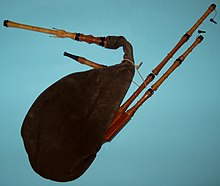Huemmelchen

The hümmelchen is a type of small German bagpipe, attested in Syntagma Musicum[1] by Michael Praetorius during the Renaissance.
Early versions are believed to have double-reeded chanters, most likely with single-reeded drones.
The word "hümmelchen" probably comes from the Low German word hämeln meaning "trim". This may refer to the hümmelchen's small size, resembling a trimmed-down version of a larger bagpipe. Another possibly etymology comes from the word hummel ("bumblebee"), referring to the buzzing sound of the drone. The term hummel is still used to refer to a type of droning zither in Germanic countries.
External links[edit]
- ^ Praetorius, Michael; Richter, Johann; Holwein, Elias (1615). Syntagma musicum : ex veterum et recentiorum, ecclesiasticorum autorum lectione, polyhistorum consignatione, variarum linguarum notatione, hodierni seculi usurpatione, ipsius denique music©Œ artis observatione : in cantorum, organistarum, organop¿orum, c©Œterorumque musicam scientiam amantium & tractantium gratiam collectum : et secundum generalem indicem toti operi pr©Œfixum, in quatuor tomos distributum. Boston Public Library. [Wittenberg] : [Johann Richter] ; [Wolffenbuttel] : [Elias Holwein].
{{cite book}}: C1 control character in|publisher=at position 45 (help)
